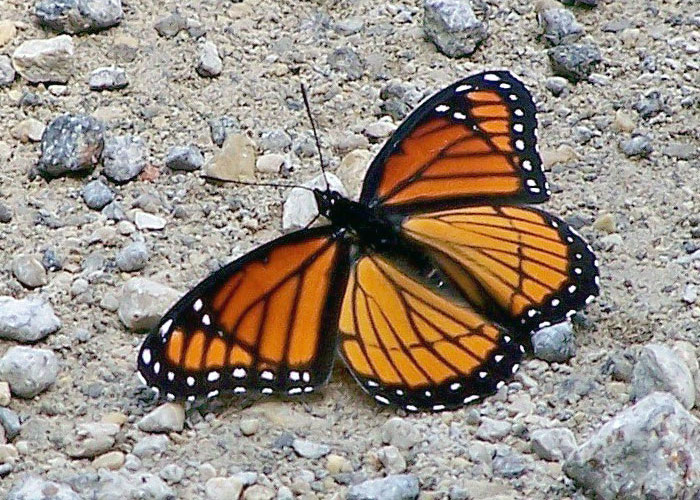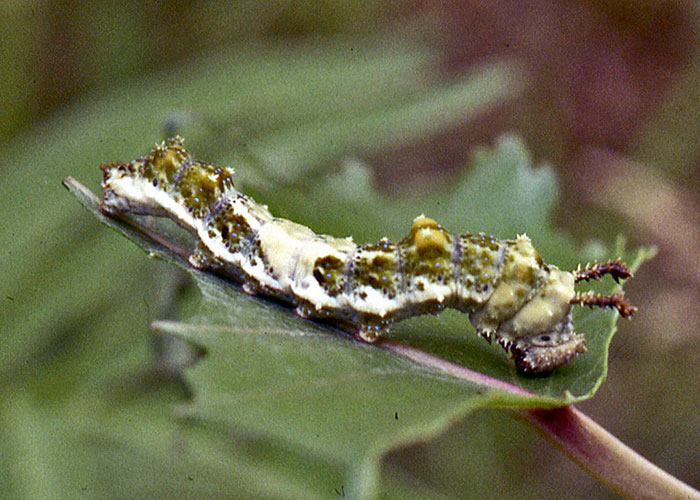Howdy, BugFans,
Viceroy Butterflies
Viceroy butterflies (Limenitis archippus) are found in the family Nymphalidae, the Brushfoot butterflies. This group is often called the “four-foot” butterflies because they carry their short front legs tucked up against their body. Viceroys are famous for being mimics of Monarch butterflies, of previous BOTW fame. Monarch caterpillars eat only milkweed foliage, and that makes them both bitter and toxic. After their first experience with Monarchs, birds generally leave them—and, by association, Viceroys—alone (of course, some butterflies die so that birds may learn). Back to that in a minute.
As Pyle points out in The Audubon Society Field Guide to North American Butterflies, Viceroys seek protection in each life stage by disguising themselves as something else. Eggs resemble galls on willow leaves. There are at least two generations of Viceroys per summer (depending on your/their latitude); the early broods live out their life cycles in a few months, but the larvae of the final brood of summer will overwinter as tiny caterpillars, wrapped in leaves of one of their food plants (willow is favored, but they’ll also eat poplar, aspen and some apple/plum/cherry leaves).
Donald W. Stokes, in A Guide to Observing Insect Lives, describes how the caterpillar shapes a leaf into its hibernaculum, according to pre-programmed specifications. It eats the leaf from the tip down, sparing the midrib. Then it rolls the remaining bit of leaf into a cylinder a half-inch long and an eighth-inch wide, securing it with silk. It lines the inside of the leaf with silk, and, although the leaf is still attached to the shrub, it wraps silk around the leaf stem (petiole) and secures it with a band around the twig so the leaf will not fall in autumn.
The caterpillar that re-emerges in spring has catkins and new leaves to feed on. As it molts and matures over the next few weeks, it looks increasingly like a blob of bird poop. For another champion bird-poop mimic, Google the “Beautiful wood nymph moth” (remember the quotation marks; the BugLady is not responsible for the sites you’ll get to if you forget the quotation marks). The chrysalis continues the bird-poop theme. Viceroys are closely related to the Red-spotted Purple/White Admiral Butterfly (Limenitis arthemis) (the Purple and the Admiral species have been “lumped” and are sometimes called the “Red-spotted Admiral.”). Its caterpillars overwinter in the same fashion as the Viceroy’s, are also bird-poop mimics, and are so similar to Viceroy caterpillars that only their mamas can distinguish them for sure.
[metaslider id=6715]
Monarchs tend to flap and soar, holding their wings up in a wide “V,” while Viceroys fly with faster wingbeats, and when they soar, their wings are held more horizontally. Viceroys enjoy shrubby and open fields and wet meadows where they feed on nectar from a variety of flowers. According to The Butterflies of Illinois, the adults’ diet changes as the season progresses, and they chow down on ripe fruit, sap flows, carrion, poop, and aphid honeydew. Males bask on leaves, scanning their horizons for females, and they will chase intruding males for considerable distances up into the sky.
The theory has always been that Viceroys have enjoyed a Lepidopteran “Get-out-of-Jail-Free” card due to their resemblance to Monarchs. Recent research suggests that Viceroys may also be distasteful, probably because willow leaves are very bitter. In that case, Monarchs and Viceroys are mimicking each other.
As mimics go, the Viceroy is a flexible one. Monarchs do not occur in the far southeastern or southwestern United States during the summer. There, Viceroys’ upper wings are a rich brown, mirroring a close Monarch kin called the Queen butterfly.
The BugLady

